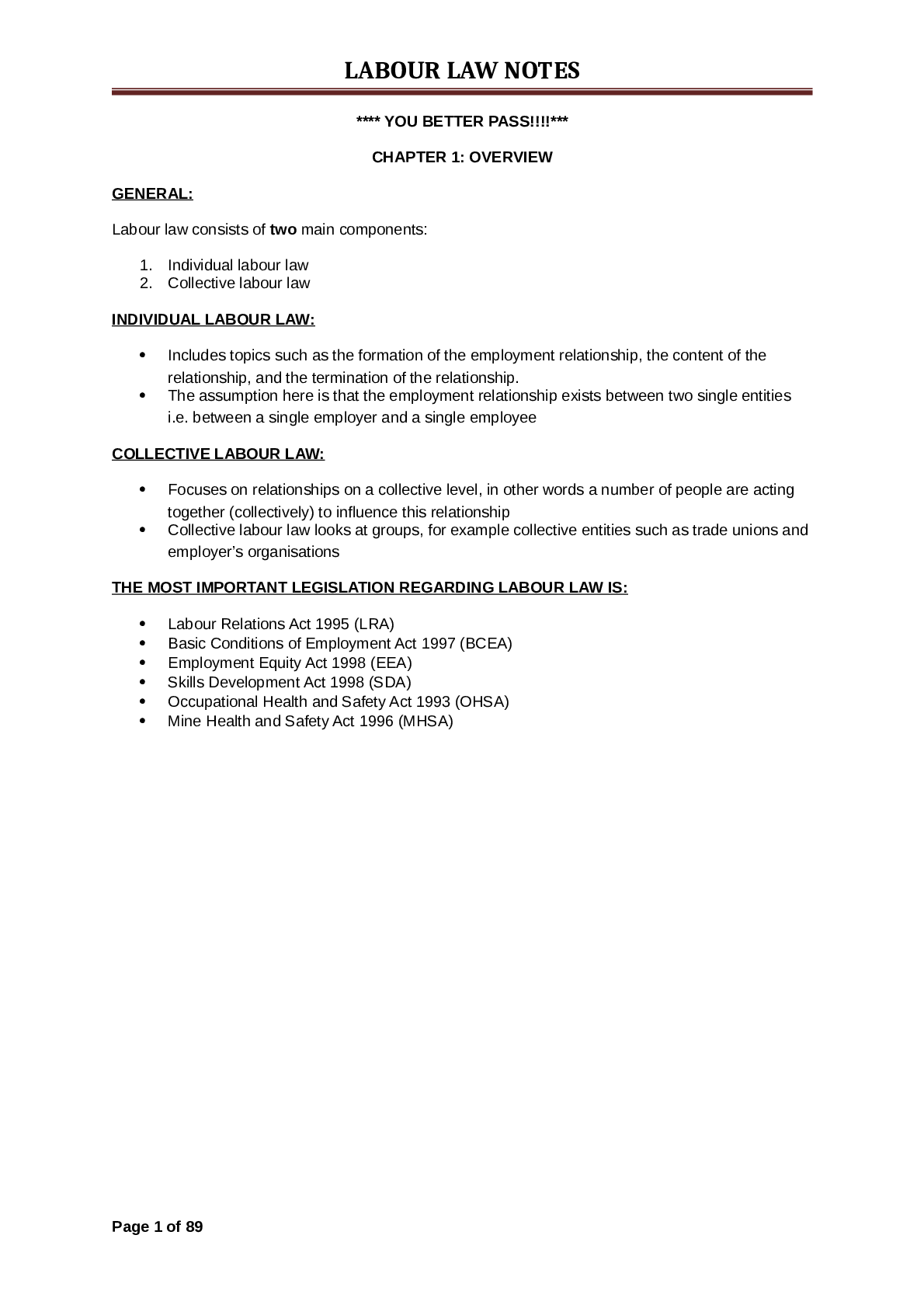GENERAL:
Labour law consists of two main components:
1. Individual labour law
2. Collective labour law
INDIVIDUAL LABOUR LAW:
Includes topics such as the formation of the employment relationship, the content of the
relationship, and the termination of the relationship.
The assumption here is that the employment relationship exists between two single entities
i.e. between a single employer and a single employee
COLLECTIVE LABOUR LAW:
Focuses on relationships on a collective level, in other words a number of people are acting
together (collectively) to influence this relationship
Collective labour law looks at groups, for example collective entities such as trade unions and
employer’s organisations
THE MOST IMPORTANT LEGISLATION REGARDING LABOUR LAW IS:
Labour Relations Act 1995 (LRA)
Basic Conditions of Employment Act 1997 (BCEA)
Employment Equity Act 1998 (EEA)
Skills Development Act 1998 (SDA)
Occupational Health and Safety Act 1993 (OHSA)
Mine Health and Safety Act 1996 (MHSA)
Page 1 of 89
LABOUR LAW NOTES
CHAPTER 2: EXCLUSIVE PROTECTION FOR EMPLOYEES IN TERMS OF LEGISLATION
WHAT IS AN EMPLOYMENT CONTRACT?
The contract of employment:
is a voluntary agreement between two parties in terms of which
one party (the employee) places his or her labour potential at the disposal and under the
control
of the other party (the employer) in exchange for some form of remuneration
WHO IS AN EMPLOYEE?
The LRA, BCEA, EEA and SEA all use the same definition of an “employee”, and employee is:
(a) Any person, excluding an independent contractor, who works for another person or for the
State and who receives, or is entitled to receive, any remuneration; and
(b) Any person who in any manner assists in carrying on or conducting the business of an
employer
Part (a) of the definition includes both employees:
in the private sector (“who works for another person”)
and the public sector (“or for the state”)
the definition also includes domestic and farm workers as employees
Part (a) incorporates the common-law contract of service (locatio conduction operarum) and
excludes the contract of work (locatio conduction operis), which relates to the contract of work
Part (b) includes any person who in any manner assists in carrying on or conducting the
business of the employer, it should be noted that this part is couched in broader terms and can
include various categories of workers, which complicates the matter as far as the distinction between
an employee and independent contractor is concerned.
Such categories include:
permanent employees
temporary employees
casual workers
contract workers
part-time employees
self-employed people
and others such as seasonal workers
The difficulty in determining who qualifies as an employee and who does not has prompted
the courts to formulate various tests to distinguish between them, the various test are:
the control test,
the organisation test, and
the dominant impression test
Page 2 of 89
LABOUR LAW NOTES
Control Test Organisation Test Dominant Impression Test
The test looks at the control:
over the type of work
the person does,
the manner in which
the work must be done
and
when the work must be
done
This test looks at whether the
person is:
part and parcel of the
business
the person’s work is
integrated into the
business of the
employer and not just
an accessory to the
business
This test is favoured by the
courts and considers:
the employment
relationship as a
whole rather than
concentrating on one
factor
These tests help clarify the concept of “employee”, but were not sufficiently clear to solve a problem
As a result, the LRA and BCEA were amended in 2002 to include rebuttable presumption as to who
would be regarded as an employee
The presumption applies that as soon as one of the factors listed in section 200A of the LRA or
section 83A of the BCEA, is found to exist in the relationship between two parties, there is presumed
to be an employment relationship
The other party then has the opportunity to show, on a balance of probabilities that no such
relationship exists
The presumption will however not apply: to any person earning more than the amount determined by the Minister in terms of the
BCEA, and
to a work arrangement involving persons who earn amounts equal to or below the amount
determined by the Minister
Section 200A of the LRA reads as follows:
“Until the contrary is proved, a person who works for, or renders services to, any other person is
presumed to be an employee, if any one or more of the following factors are present:
(a) manner in which the person works is subject to the control or direction of another person;
(b) person’s hours of work are subject to the control or direction of another person;
(c) the case of a person who works for an organisation, the person forms part of that
organisation
(d) person has worked for that person for an average of 40 hours per month over the last three
months;
(e) person is economically dependent on the person for whom he or she works or renders
services;
(f) person is provided with tools of trade or work equipment by the other person, or
(g) person only works for or renders services to one person”
Section 200A and 83A should be read with the Code: Who is an Employee?
The Code incorporates the three tests developed by the courts, but goes further and provides
guidance for the possible interpretation and application of these tests in a modern context
Read More


